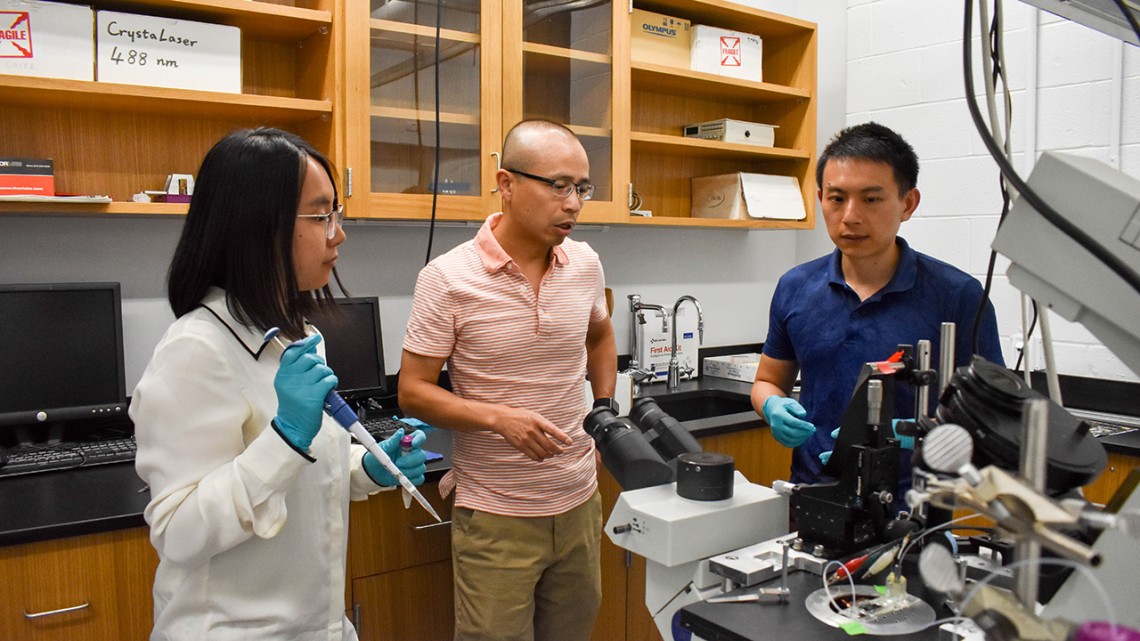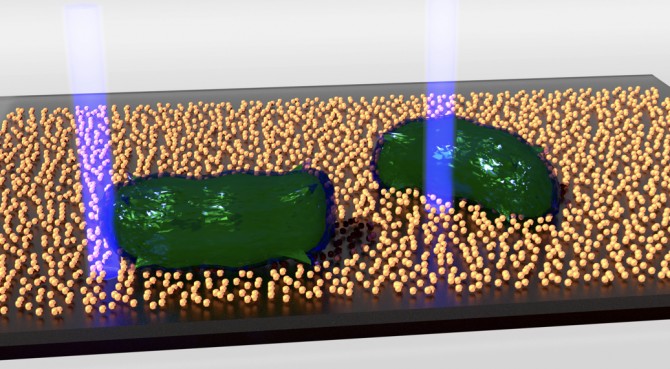
Peng Chen, the Peter J.W. Debye Professor of Chemistry, middle, works with postdoctoral associates Bing Fu and Xianwen Mao in his lab.
Interdisciplinary team gets $2M grant for bioenergy conversion
By David Nutt
The U.S. Department of Energy has awarded an interdisciplinary team of Cornell researchers $2 million to study the combination of inorganic semiconductor nanoparticles and bacterial cells for more efficient bioenergy conversion.
The team will be led by Peng Chen, the Peter J.W. Debye Professor of Chemistry in the College of Arts and Sciences, who is collaborating with Tobias Hanrath, professor at the Smith School of Chemical and Biomolecular Engineering, and Buz Barstow, Ph.D. ’09, assistant professor of biological and environmental engineering in the College of Agriculture and Life Sciences.
The Cornell project was one of six selected by the DOE’s Office of Biological and Environmental Research to explore microscopic imaging of plants and microbes as a way to advance bioenergy research.
The Cornell team is focusing on inorganic semiconductor nanoparticles called quantum dots, which have strong light-absorbing properties, and merging them with bacteria cells that can perform complicated chemical transformations precisely and efficiently. The resulting hybrid system will be able to harvest sunlight and utilize carbon dioxide that is abundant in the atmosphere to produce both high-value chemicals like plastic precursors and commodities like the infrastructure-compatible biofuel butanol and the bio-plastic polyhydroxybutyrate (PHB).
“This is a system that others have shown to work, and it’s very promising, but it hasn’t been brought to large scale or with extremely high efficiencies yet,” Chen said. “We need to understand how the system works at a fundamental level – and find the underlying factors that will contribute or limit the performance – so we can potentially engineer and improve it.”
Chen’s lab will handle the measurement and particle imaging, while Hanrath will synthesize and tailor the quantum dots. Barstow will engineer and genetically modify the bacteria.
“We were already pursuing this type of research, and when the DOE called for multidisciplinary projects, I contacted Tobias and Buz and we wrote the proposal,” Chen said. “It really is a multidisciplinary, collaborative effort that reaches across campus.”
“This research explores the intriguing prospect of influencing the complex biomachinery inside bacterial cells through interactions with external quantum dots," Hanrath said. “Improved understanding of, and ultimately control over, how cells and quantum dots interact has important broader implications beyond the specific model system investigated in this project.”
Media Contact
Get Cornell news delivered right to your inbox.
Subscribe

